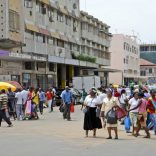Mozambique: Banks focused on solving shortage of foreign currency - AIM
Mozambique banking likely to grow less than 5 percent this year – BMI research

Voa (File photo) / Central Bank in Maputo
BMI Research consultancy said on Thursday that, due to the country’s economic difficulties, the banking sector asset growth rate in Mozambique is expected to fall to less than 5 percent this year, and still be below 8 percent in 2018.
“The commercial banking industry faces two challenging years, as the economy weakens despite the demand for credit and lower asset quality,” write the Fitch group analysts.
In the analysis of Mozambique’s financial sector, to which Lusa has access, the analysts write that “total asset growth was around 23 percent per year between 2010 and 2015, before falling dramatically in 2016 to only 7.9 percent” and anticipate that “the growth of the sector will be slow in the short term, reaching only 4.8 percent and 7.9 percent in this and next year, respectively”.
This negative view of developments in the Mozambican banking sector in 2017 and 2018 “is mainly the result of the debt crisis that culminated in the financial default” of January, when the government failed almost US$60 million on sovereign bonds maturing in 2023.
Public debt, which BMI Research estimates to be at 109 percent of gross domestic product this year, will hamper economic recovery, as will the austerity measures required.
“Any future negotiations with the International Monetary Fund and creditors should stipulate severe cuts in public spending to try to stabilize the debt burden, which will slow down the demand for credit in the domestic banking sector,” BMI Research says.
The domestic private sector will not make a major contribution to the appreciation of assets, since it is also penalised by the poor performance of the sectors most affected by the public debt crisis, especially construction.
“Beyond commodity territory, we believe that the development of major infrastructure projects will be a rarity for the construction industry in the next two years because of budget constraints and weak investor sentiment,” analysts say.
The report also notes that the default environment increases risk for the financial sector, with the budget deficit improving to 6.3 percent of GDP from an estimated 8.8 percent last year.
“However, the increasing cost of debt service may undermine the government’s ability to assist any struggling banks,” says BMI Research, stressing that the ratio of government debt to GDP was 42.2 percent in 2014 and is expected to rise to almost 110 percent of GDP this year.
On a positive note, analysts point out that the largest Mozambican banks are owned by external entities. “Millennium BIM, BCI, Standard Bank, Barclays, Moza and Banco Único represent 90 percent of the sector’s assets, which we see as positive in a prospective of financial stability,” the analysts conclude.












Leave a Reply
Be the First to Comment!
You must be logged in to post a comment.
You must be logged in to post a comment.